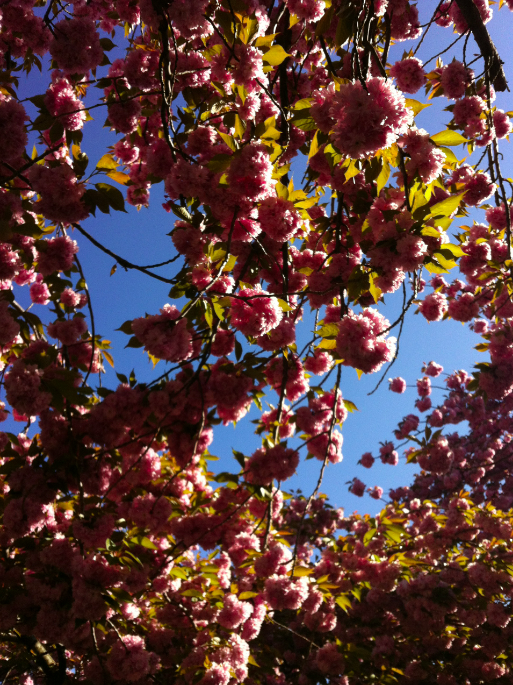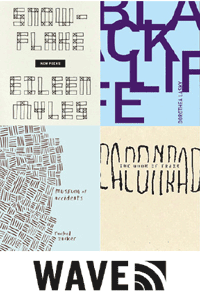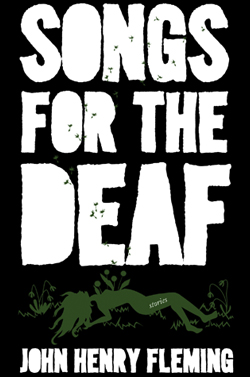Innovators in Lit #5: Paper Darts
Paper Darts founders Jamie Millard, Regan Smith, and Meghan Suszynski are “taking back the lit scene, one lame pen and quill metaphor at a time.” Since 2009 Paper Darts has produced a reliably gorgeous magazine, and the organization recently expanded to include a press, which will soon publish its first title, John Jodzio’s Get In If You Want To Live, a collection of 19 stories accompanied by illustrations from 19 artists. Jamie, Regan, and Meghan were kind enough to chat about widening readerships for literary magazines, succeeding in a crappy economy, Minneapolis, and bringing the fun back into literature.
Laura: Paper Darts was founded in 2009. How did you get your start?
Paper Darts: The three of us first met in 2008 while working on the staff of the Ivory Tower, the University of Minnesota’s undergraduate literary magazine. After graduating in May of ‘09 into a horrible economy, we were left with the feeling of “Okay, now what?” Putting the extra time our underemployment afforded us to good use, we set out to bring our community a new kind of literary magazine—something that embraced color, design, humor, and risk, and really utilized social media in a way we hadn’t seen much before.
The whole process of getting started was extremely grassroots, mostly a matter of meeting in coffee shops and our apartments everyday and saying “let’s do this.” We solicited work from our artist and writer friends until outside submissions began rolling in, taught ourselves web design and built paperdarts.org, and embraced a print-on-demand model to keep costs in line with our budget of $0.00. We had a pretty diverse array of skills going into it (design/illustration, project management, writing, etc.) which have developed immensely over the past two years, but by far the most important thing we ever put into Paper Darts was a LOT of hard work
Laura: In addition to publishing a magazine, Paper Darts also runs a press and a creative agency for freelance hire. Can you talk a little about each of these entities and how it all works together?
Paper Darts: While the press and creative agency are relatively new, we’ve always looked at Paper Darts as an idea—not just a magazine. Though it’s defined to the outside world through its tangible products, it’s defined in our minds as something intangible, something bigger than the sum of its parts. Part of the Paper Darts Idea is that content (whether Literature with a capital L, humorous short stories, or the text on an author’s website) should be accessible and engaging. We strive to make all types of content exciting and inclusive through imaginative design and a strong personal voice, and we believe we can bring these elements to other creative areas outside our magazine.
Laura: In an interview with Minnesota Public Radio, you talk about putting humor and fun back into the lit mag world. Could you expand on the Paper Darts sensibility a bit?
Paper Darts: We’ve always felt that literary magazines are an extremely important and undervalued part of the publishing world, and as undergraduates, we spent an entire year studying lit mags from across the world. Some of them were getting it right and reaffirming our belief in their inherent value, but it was sad for us to discover that the vast majority were essentially bringing their obsolescence onto themselves. Most of them were visually unappealing, dominated by heavy white and black blocks of text, and the language was overly flowery and clearly took itself much too seriously. Literary magazines too often cater to an MFA audience, or an audience of writers reading writers. We are interested in widening the scope of readership for literary magazines. Our magazine anticipates a very real audience of readers; we imagine our Paper Darts readers to have busy lives and real jobs, whether they are readers in office cubicles, coffee houses, the beach, the bus, or their parents’ basements.
With Paper Darts we saw a chance to revamp the lit mag world’s image. We pair images, design, illustrations, and beautiful colors. With each and every piece we publish, we are paying homage to a children’s book aesthetic forsaken in the adult literary world. In addition to that, we’ve also worked extremely hard to pair that visual voice with our written voice as well. Though it’s difficult to clearly define that voice, we like to believe everything that’s written from the PD POV (web copy, press releases, social media, etc) and every piece of work we publish is a reflection of the overall tone we’re attempting to curate. It sounds lame, but we’re really looking to interact with our audience in the way we hope they’ll interact with us. Not as bleeding ink and quill writers and dramatic starving artists, but as fun, creative, and welcoming people who just want to be part of a creative community.
Laura: The first book Paper Darts Press publishes will be Get In If You Want To Live, a collection of 19 fiction short-shorts by John Jodzio (author of the terrific collection If You Lived Here You’d Already Be Home). How you did come to select this collection as PDP’s first book?
Paper Darts: We were fortunate enough to have previously worked with John on several occasions. We first met at the Opium Literary Death Match in April of 2010, collaborated with him on a string of events the following summer, then published an interview and his short story “Javier” in Paper Darts Magazine Volume Three. Knowing John’s work we were already incredibly honored when he sent us his manuscript, and once we had the chance to actually look at it, it was a no-brainer. John’s writing embodies every attribute we look for in our role as publishers: it’s digestible, risky, and hilarious, but also laced with a poignancy that lingers in your mind long after reading. He’s one of those authors that leaves you wondering “how in the hell did somebody think of that?” in the best possible way. We absolutely could not have asked for a better writer for Paper Darts Press’ debut project.
Laura: PDP is “ushering in a new approach to creative publishing, based on the intimate collaboration between an author/artist/publisher trifecta.” What does such a collaboration look like?
Paper Darts: We have a chemist’s curiosity for the collaborative effects of combining visual arts with the written word. We are interested in the kind of stories that can be told respectively through art and through literature. The kind of stories that will dazzle you with their brilliance and then punch you in the gut and steal your wallet. It is fascinating to see how an author’s work can grow when interpreted by an artist or illustrator. Even better, it is so enriching as a publisher to send that collaborative effort off into the world to interact and grow further in the imagination of our readers. We whole-heartedly believe that through the marrying of Art and Lit, readers live on happily ever after, with a deeper connection to both the stories and the artwork.
We are very engaged publishers with our own artistic investment in the end result. We like to think of the author, artist, and publisher as equal collaborators and co-conspirators. The lines between art and illustration will be blurred. We like that. John was kind and brave enough to give Paper Darts and the 19 artists working on his book full artistic control over his stories. Of course the illustrator we pair with a piece of literature will speak volumes upon the actual meat of the writing, however, we do not believe illustration detracts from the writing. The collaboration simply creates something new, something a writer, reader, or artist can consistently expect from Paper Darts.
Laura: In an interview with Zach Dodson, I asked about how featherproof “reach[es] through the noise,” given how much is going on out there. Do you find it’s challenging for a relatively new publishing enterprise to cut through the noise? How will Paper Darts work to connect with an audience?
Paper Darts: If you build it, they will come, right? Our recipe for longevity in this era of social media and the dwindling attention span is a commitment to perseverance and consistency. Using social media appropriately and inventively has truly helped us connect with a larger audience then we could ever have imagined. We get around 25,000 visits to our site a month. Which for a small and relatively new literary magazine, run by little-known, unkempt twentysomethings, is pretty darn amazing. We are doggedly working to keep Paper Darts alive. That is as much as we can do with full time jobs on the side. Though our stint as publishers has been relatively short, we have seen all too many literary publications rise and fall over the last two years. I would bet the death of a literary magazine can be traced to one of two things, workload or the inability to play nice with others. We genuinely like each other. We all share an insane work ethic. We will just keep on keeping on.
Laura: What’s been one of your most exciting moments or experiences with Paper Darts?
Paper Darts: It takes time to build a community. It takes time to develop relationships and garner respect. It took more time than we imagined in the beginning, but now that we have made it to our two year anniversary, many organizations, press outlets, and creatives, and an amazing community of readers have taken notice. Getting recognized by the publications we’d been striving to be noticed by for a year and half was as rewarding as we hoped it would be. The opportunity to publish an author we look up to both personally and professionally has been life-changing, and the fact that 20 hugely talented and successful artists were willing to selflessly donate their time illustrating the book simply because they believe in and support the PD Idea reminds us over and over again that 30 hours a week of dedication to this labor of puppy love is worth it.
Laura: What are some other publishers or literary entities that you find inspiring?
Paper Darts: Nationally, we are inspired by the masters of irreverence and design, McSweeney’s, Zoetrope: All-Story and Opium. We love the online publishers The Hairpin and The Tangential—another baby of Minneapolis. Also, we are inspired by non-traditional publishers like Marc Maron of the WTF podcast. His ultra-personal interviews with comics are revolutionary, and his approach to everything from the aesthetic of his website to his implementation of a fair paywall system is spot on. We are also inspired by the opportunities presented to regular-joes turned curators by general and easy publishing platforms like tumblr and pinterest.
Laura: Paper Darts is based in Minneapolis. What’s the literary community like there?
Paper Darts: We can’t say enough about how good the Twin Cities literary community has been to us. There is absolutely always something to do, and it’s a lot cooler, younger, and more popular than a lot of people on the outside give it credit for. There’s a new wave of the literary “in-crowd” that’s been building itself up in Minneapolis for a couple years now, and it’s underground enough to be a little intimidating and feel slightly inaccessible to people who are new to the cities or are just starting to get involved, but it’s definitely just a misconception borne out of inexperience. Once you actually get out there and get to the events on a regular basis and start talking and drinking with the people around you, it’s impossible not to become wholly enveloped in the culture. People here are so nice, and so humble, and so excited and willing to meet other members of the community and have a good time.
Laura: What do you wish existed in publishing that hasn’t been invented yet?
Paper Darts: A giant printer vending machine where you could instantly pair your favorite artists with your favorite writers and print out the combinations in a perfect-bound booklet made of fine paper for the price of a candy bar. Until then, you will just have to find your favorite artists and writers perfectly bound in the Paper Darts’ online store.


